Report on Developing Effective Teams in Business (Chez Bruce)
VerifiedAdded on 2021/02/19
|12
|4098
|51
Report
AI Summary
This report analyzes the development of effective teams within the context of Chez Bruce Restaurant's marketing team, focusing on the launch of a new Arabian cuisine-themed product. It covers various team types (formal, informal, temporary, permanent, cross-functional, and self-managed teams) and their benefits, emphasizing increased productivity, improved performance, and skill development. The report also explores how to build cohesive teams using Tuckman's stages of team development (forming, storming, norming, performing, and adjourning). Furthermore, it details the attributes and skills required of a team leader, including trustworthiness, communication, and decision-making. The assignment includes a comparison of team roles based on Belbin's team role theory and an evaluation of different team types' effectiveness. Finally, the report discusses demonstrating effective teamwork and dealing with conflict to achieve specific goals.
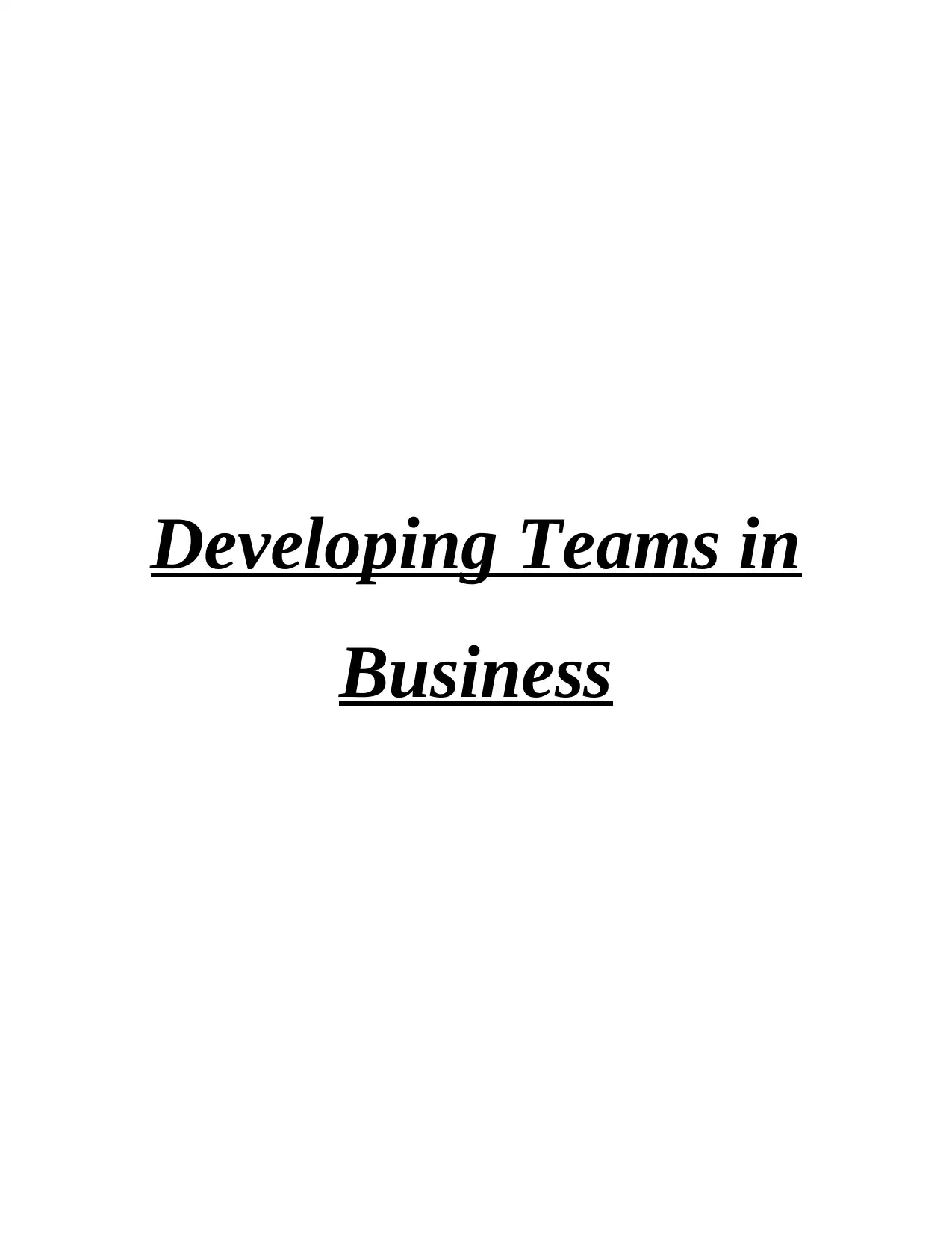
Developing Teams in
Business
Business
Paraphrase This Document
Need a fresh take? Get an instant paraphrase of this document with our AI Paraphraser
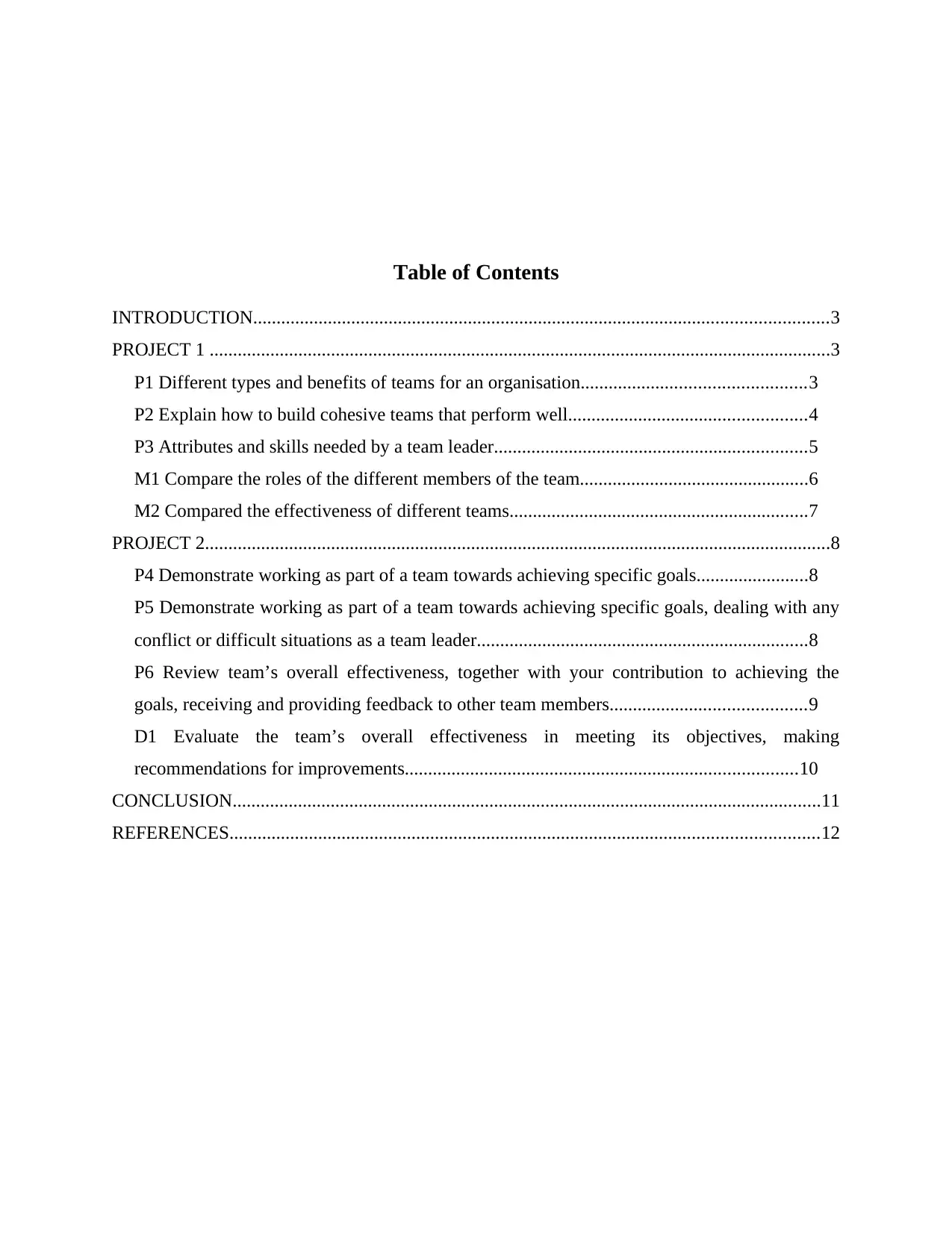
Table of Contents
INTRODUCTION...........................................................................................................................3
PROJECT 1 .....................................................................................................................................3
P1 Different types and benefits of teams for an organisation................................................3
P2 Explain how to build cohesive teams that perform well...................................................4
P3 Attributes and skills needed by a team leader...................................................................5
M1 Compare the roles of the different members of the team.................................................6
M2 Compared the effectiveness of different teams................................................................7
PROJECT 2......................................................................................................................................8
P4 Demonstrate working as part of a team towards achieving specific goals........................8
P5 Demonstrate working as part of a team towards achieving specific goals, dealing with any
conflict or difficult situations as a team leader.......................................................................8
P6 Review team’s overall effectiveness, together with your contribution to achieving the
goals, receiving and providing feedback to other team members..........................................9
D1 Evaluate the team’s overall effectiveness in meeting its objectives, making
recommendations for improvements....................................................................................10
CONCLUSION..............................................................................................................................11
REFERENCES..............................................................................................................................12
INTRODUCTION...........................................................................................................................3
PROJECT 1 .....................................................................................................................................3
P1 Different types and benefits of teams for an organisation................................................3
P2 Explain how to build cohesive teams that perform well...................................................4
P3 Attributes and skills needed by a team leader...................................................................5
M1 Compare the roles of the different members of the team.................................................6
M2 Compared the effectiveness of different teams................................................................7
PROJECT 2......................................................................................................................................8
P4 Demonstrate working as part of a team towards achieving specific goals........................8
P5 Demonstrate working as part of a team towards achieving specific goals, dealing with any
conflict or difficult situations as a team leader.......................................................................8
P6 Review team’s overall effectiveness, together with your contribution to achieving the
goals, receiving and providing feedback to other team members..........................................9
D1 Evaluate the team’s overall effectiveness in meeting its objectives, making
recommendations for improvements....................................................................................10
CONCLUSION..............................................................................................................................11
REFERENCES..............................................................................................................................12

INTRODUCTION
Team is defined as group of individuals who work together for achievement of goals and
objectives (Bedwell, Fiore and Salas, 2014). They are interdependent in terms of resources,
skills, information who are seeking for combining efforts to accomplish and achieve common
goal of business. It is very important for organisation to build successful team as there is right
mix of various professional skills. This team helps in better achievement of goal and objectives.
The given report is based on Chez Bruce Restaurant which was founded in 1995 at United
Kingdom. It is medium sized restaurant providing various foods and drinks to their users or
consumers. Being part of marketing team in respective organisation for new product, it is
important for them to develop teams. The new product is based on Arabian Cuisine theme. This
report highlights about importance of team, team development, leadership attributes and skill. It
also covers that employees of organisation should be able to work effectively in team.
PROJECT 1
P1 Different types and benefits of teams for an organisation
Team is defined as group of people which is working together for achievement of
specified goal (Boyatzis and et. al., 2013). This is formed with two, four or six people or more
than that for better results. As being part of marketing team at Chez Bruce Restaurant, team has
to be formed for delivering plan for new product. The different types of teams for an
organisation are described below:
Formal Teams- It is created for particular purpose in systematic and structured manner.
This team has to follow proper rules and regulation in order to meet expectation of each and
every members. For example, customer service where there is proper rules and regulation to deal
with them.
Informal Teams- This is defined as team where there is no proper structure, rule and
regulations. It is formed informally for organisation to assist team. For instance, combination of
different team members for work performance.
Temporary Teams- This is created for shorter period of time for achievement of
particular task. Such team is separated after completion of task and loose importance as team is
temporal. There are various types of teams which are of temporary in nature such as task force,
project design, problem solving teams.
Team is defined as group of individuals who work together for achievement of goals and
objectives (Bedwell, Fiore and Salas, 2014). They are interdependent in terms of resources,
skills, information who are seeking for combining efforts to accomplish and achieve common
goal of business. It is very important for organisation to build successful team as there is right
mix of various professional skills. This team helps in better achievement of goal and objectives.
The given report is based on Chez Bruce Restaurant which was founded in 1995 at United
Kingdom. It is medium sized restaurant providing various foods and drinks to their users or
consumers. Being part of marketing team in respective organisation for new product, it is
important for them to develop teams. The new product is based on Arabian Cuisine theme. This
report highlights about importance of team, team development, leadership attributes and skill. It
also covers that employees of organisation should be able to work effectively in team.
PROJECT 1
P1 Different types and benefits of teams for an organisation
Team is defined as group of people which is working together for achievement of
specified goal (Boyatzis and et. al., 2013). This is formed with two, four or six people or more
than that for better results. As being part of marketing team at Chez Bruce Restaurant, team has
to be formed for delivering plan for new product. The different types of teams for an
organisation are described below:
Formal Teams- It is created for particular purpose in systematic and structured manner.
This team has to follow proper rules and regulation in order to meet expectation of each and
every members. For example, customer service where there is proper rules and regulation to deal
with them.
Informal Teams- This is defined as team where there is no proper structure, rule and
regulations. It is formed informally for organisation to assist team. For instance, combination of
different team members for work performance.
Temporary Teams- This is created for shorter period of time for achievement of
particular task. Such team is separated after completion of task and loose importance as team is
temporal. There are various types of teams which are of temporary in nature such as task force,
project design, problem solving teams.
⊘ This is a preview!⊘
Do you want full access?
Subscribe today to unlock all pages.

Trusted by 1+ million students worldwide
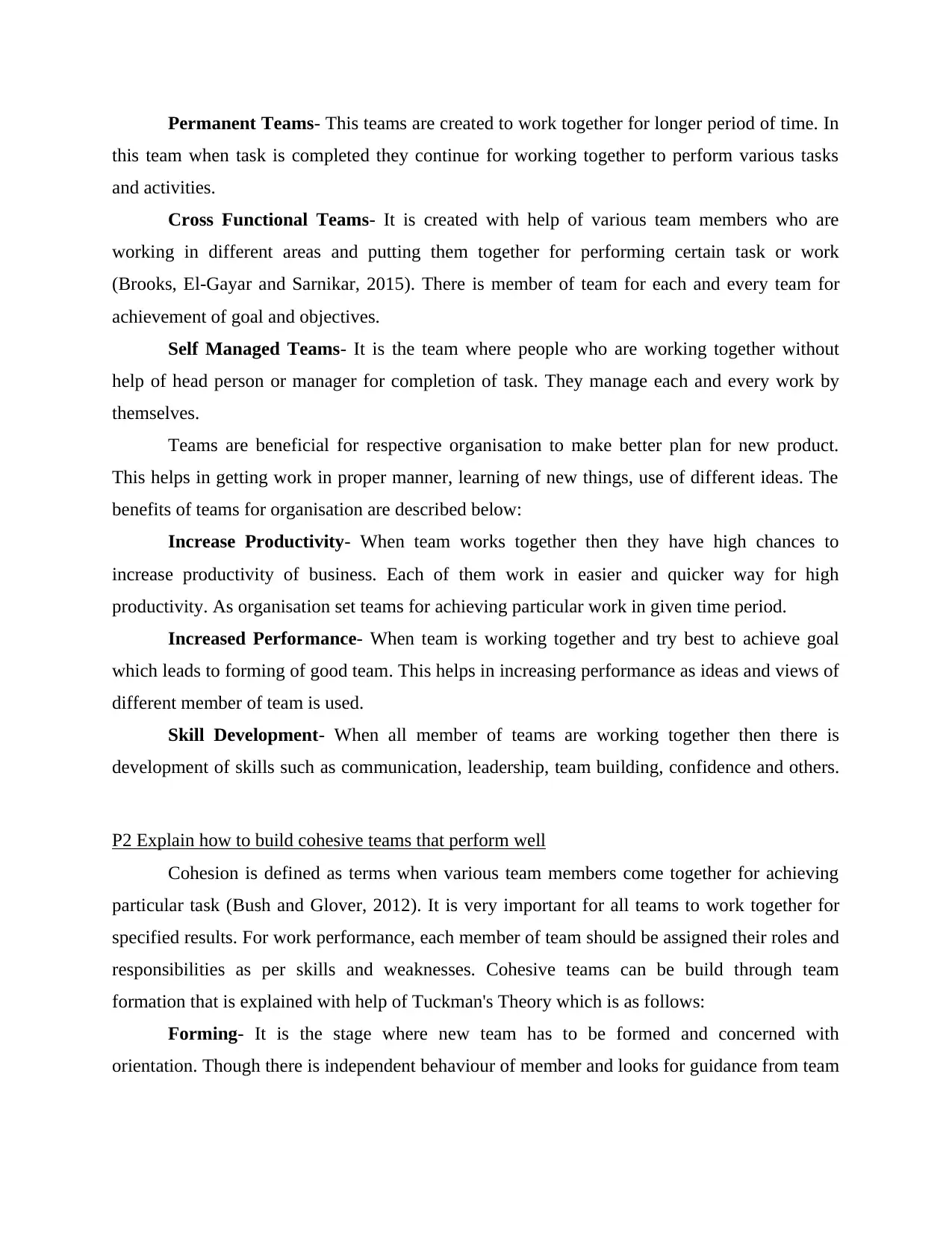
Permanent Teams- This teams are created to work together for longer period of time. In
this team when task is completed they continue for working together to perform various tasks
and activities.
Cross Functional Teams- It is created with help of various team members who are
working in different areas and putting them together for performing certain task or work
(Brooks, El-Gayar and Sarnikar, 2015). There is member of team for each and every team for
achievement of goal and objectives.
Self Managed Teams- It is the team where people who are working together without
help of head person or manager for completion of task. They manage each and every work by
themselves.
Teams are beneficial for respective organisation to make better plan for new product.
This helps in getting work in proper manner, learning of new things, use of different ideas. The
benefits of teams for organisation are described below:
Increase Productivity- When team works together then they have high chances to
increase productivity of business. Each of them work in easier and quicker way for high
productivity. As organisation set teams for achieving particular work in given time period.
Increased Performance- When team is working together and try best to achieve goal
which leads to forming of good team. This helps in increasing performance as ideas and views of
different member of team is used.
Skill Development- When all member of teams are working together then there is
development of skills such as communication, leadership, team building, confidence and others.
P2 Explain how to build cohesive teams that perform well
Cohesion is defined as terms when various team members come together for achieving
particular task (Bush and Glover, 2012). It is very important for all teams to work together for
specified results. For work performance, each member of team should be assigned their roles and
responsibilities as per skills and weaknesses. Cohesive teams can be build through team
formation that is explained with help of Tuckman's Theory which is as follows:
Forming- It is the stage where new team has to be formed and concerned with
orientation. Though there is independent behaviour of member and looks for guidance from team
this team when task is completed they continue for working together to perform various tasks
and activities.
Cross Functional Teams- It is created with help of various team members who are
working in different areas and putting them together for performing certain task or work
(Brooks, El-Gayar and Sarnikar, 2015). There is member of team for each and every team for
achievement of goal and objectives.
Self Managed Teams- It is the team where people who are working together without
help of head person or manager for completion of task. They manage each and every work by
themselves.
Teams are beneficial for respective organisation to make better plan for new product.
This helps in getting work in proper manner, learning of new things, use of different ideas. The
benefits of teams for organisation are described below:
Increase Productivity- When team works together then they have high chances to
increase productivity of business. Each of them work in easier and quicker way for high
productivity. As organisation set teams for achieving particular work in given time period.
Increased Performance- When team is working together and try best to achieve goal
which leads to forming of good team. This helps in increasing performance as ideas and views of
different member of team is used.
Skill Development- When all member of teams are working together then there is
development of skills such as communication, leadership, team building, confidence and others.
P2 Explain how to build cohesive teams that perform well
Cohesion is defined as terms when various team members come together for achieving
particular task (Bush and Glover, 2012). It is very important for all teams to work together for
specified results. For work performance, each member of team should be assigned their roles and
responsibilities as per skills and weaknesses. Cohesive teams can be build through team
formation that is explained with help of Tuckman's Theory which is as follows:
Forming- It is the stage where new team has to be formed and concerned with
orientation. Though there is independent behaviour of member and looks for guidance from team
Paraphrase This Document
Need a fresh take? Get an instant paraphrase of this document with our AI Paraphraser
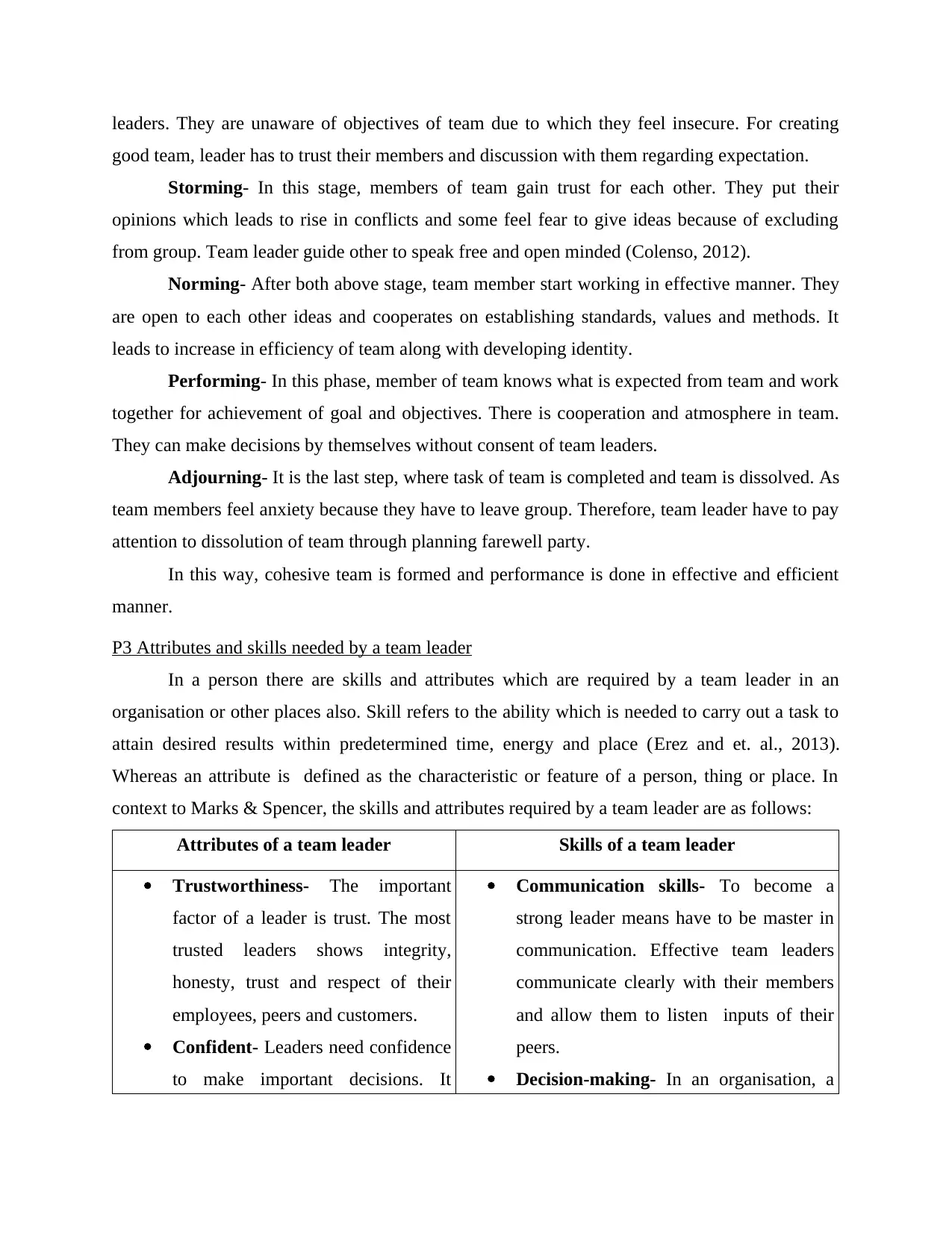
leaders. They are unaware of objectives of team due to which they feel insecure. For creating
good team, leader has to trust their members and discussion with them regarding expectation.
Storming- In this stage, members of team gain trust for each other. They put their
opinions which leads to rise in conflicts and some feel fear to give ideas because of excluding
from group. Team leader guide other to speak free and open minded (Colenso, 2012).
Norming- After both above stage, team member start working in effective manner. They
are open to each other ideas and cooperates on establishing standards, values and methods. It
leads to increase in efficiency of team along with developing identity.
Performing- In this phase, member of team knows what is expected from team and work
together for achievement of goal and objectives. There is cooperation and atmosphere in team.
They can make decisions by themselves without consent of team leaders.
Adjourning- It is the last step, where task of team is completed and team is dissolved. As
team members feel anxiety because they have to leave group. Therefore, team leader have to pay
attention to dissolution of team through planning farewell party.
In this way, cohesive team is formed and performance is done in effective and efficient
manner.
P3 Attributes and skills needed by a team leader
In a person there are skills and attributes which are required by a team leader in an
organisation or other places also. Skill refers to the ability which is needed to carry out a task to
attain desired results within predetermined time, energy and place (Erez and et. al., 2013).
Whereas an attribute is defined as the characteristic or feature of a person, thing or place. In
context to Marks & Spencer, the skills and attributes required by a team leader are as follows:
Attributes of a team leader Skills of a team leader
Trustworthiness- The important
factor of a leader is trust. The most
trusted leaders shows integrity,
honesty, trust and respect of their
employees, peers and customers.
Confident- Leaders need confidence
to make important decisions. It
Communication skills- To become a
strong leader means have to be master in
communication. Effective team leaders
communicate clearly with their members
and allow them to listen inputs of their
peers.
Decision-making- In an organisation, a
good team, leader has to trust their members and discussion with them regarding expectation.
Storming- In this stage, members of team gain trust for each other. They put their
opinions which leads to rise in conflicts and some feel fear to give ideas because of excluding
from group. Team leader guide other to speak free and open minded (Colenso, 2012).
Norming- After both above stage, team member start working in effective manner. They
are open to each other ideas and cooperates on establishing standards, values and methods. It
leads to increase in efficiency of team along with developing identity.
Performing- In this phase, member of team knows what is expected from team and work
together for achievement of goal and objectives. There is cooperation and atmosphere in team.
They can make decisions by themselves without consent of team leaders.
Adjourning- It is the last step, where task of team is completed and team is dissolved. As
team members feel anxiety because they have to leave group. Therefore, team leader have to pay
attention to dissolution of team through planning farewell party.
In this way, cohesive team is formed and performance is done in effective and efficient
manner.
P3 Attributes and skills needed by a team leader
In a person there are skills and attributes which are required by a team leader in an
organisation or other places also. Skill refers to the ability which is needed to carry out a task to
attain desired results within predetermined time, energy and place (Erez and et. al., 2013).
Whereas an attribute is defined as the characteristic or feature of a person, thing or place. In
context to Marks & Spencer, the skills and attributes required by a team leader are as follows:
Attributes of a team leader Skills of a team leader
Trustworthiness- The important
factor of a leader is trust. The most
trusted leaders shows integrity,
honesty, trust and respect of their
employees, peers and customers.
Confident- Leaders need confidence
to make important decisions. It
Communication skills- To become a
strong leader means have to be master in
communication. Effective team leaders
communicate clearly with their members
and allow them to listen inputs of their
peers.
Decision-making- In an organisation, a
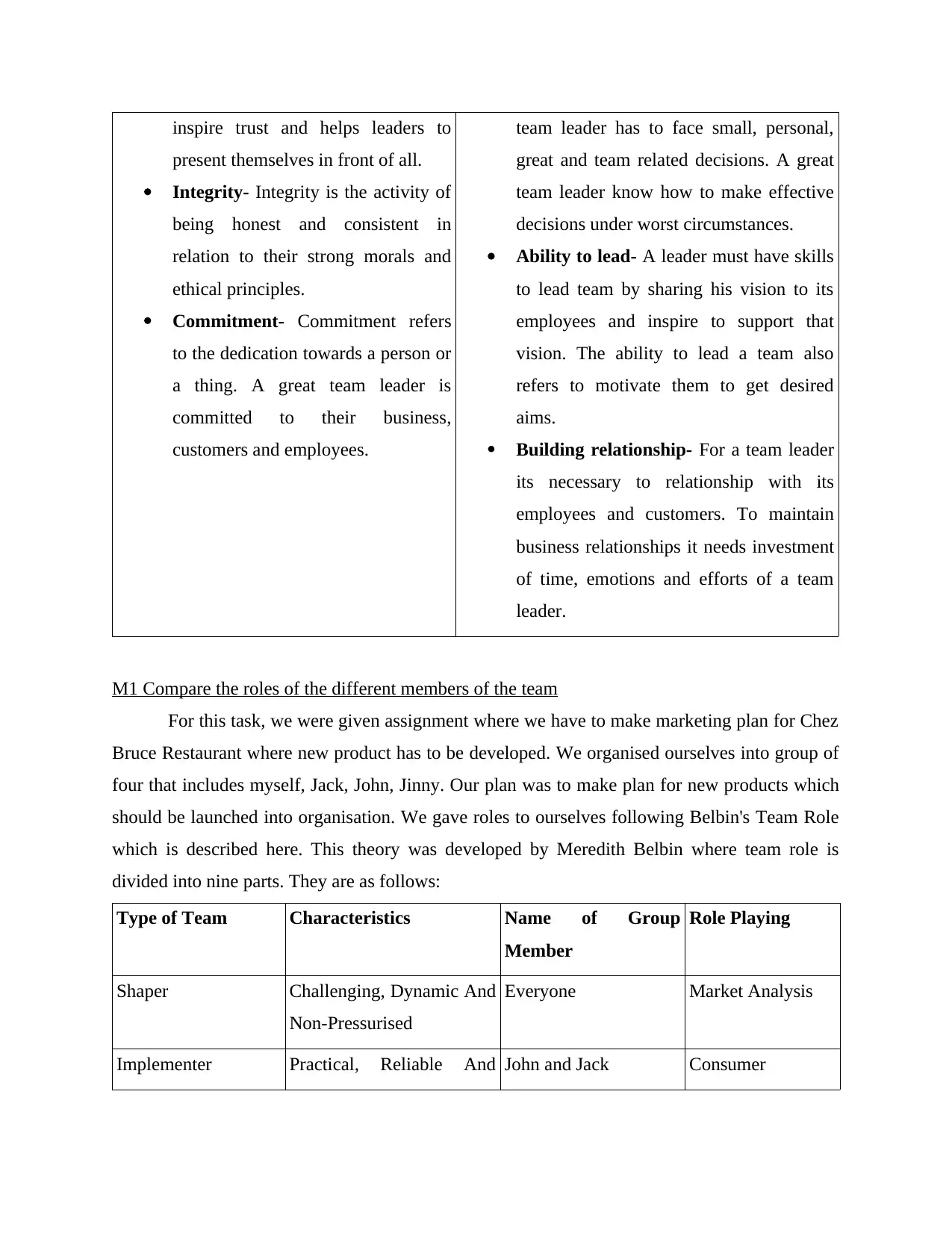
inspire trust and helps leaders to
present themselves in front of all.
Integrity- Integrity is the activity of
being honest and consistent in
relation to their strong morals and
ethical principles.
Commitment- Commitment refers
to the dedication towards a person or
a thing. A great team leader is
committed to their business,
customers and employees.
team leader has to face small, personal,
great and team related decisions. A great
team leader know how to make effective
decisions under worst circumstances.
Ability to lead- A leader must have skills
to lead team by sharing his vision to its
employees and inspire to support that
vision. The ability to lead a team also
refers to motivate them to get desired
aims.
Building relationship- For a team leader
its necessary to relationship with its
employees and customers. To maintain
business relationships it needs investment
of time, emotions and efforts of a team
leader.
M1 Compare the roles of the different members of the team
For this task, we were given assignment where we have to make marketing plan for Chez
Bruce Restaurant where new product has to be developed. We organised ourselves into group of
four that includes myself, Jack, John, Jinny. Our plan was to make plan for new products which
should be launched into organisation. We gave roles to ourselves following Belbin's Team Role
which is described here. This theory was developed by Meredith Belbin where team role is
divided into nine parts. They are as follows:
Type of Team Characteristics Name of Group
Member
Role Playing
Shaper Challenging, Dynamic And
Non-Pressurised
Everyone Market Analysis
Implementer Practical, Reliable And John and Jack Consumer
present themselves in front of all.
Integrity- Integrity is the activity of
being honest and consistent in
relation to their strong morals and
ethical principles.
Commitment- Commitment refers
to the dedication towards a person or
a thing. A great team leader is
committed to their business,
customers and employees.
team leader has to face small, personal,
great and team related decisions. A great
team leader know how to make effective
decisions under worst circumstances.
Ability to lead- A leader must have skills
to lead team by sharing his vision to its
employees and inspire to support that
vision. The ability to lead a team also
refers to motivate them to get desired
aims.
Building relationship- For a team leader
its necessary to relationship with its
employees and customers. To maintain
business relationships it needs investment
of time, emotions and efforts of a team
leader.
M1 Compare the roles of the different members of the team
For this task, we were given assignment where we have to make marketing plan for Chez
Bruce Restaurant where new product has to be developed. We organised ourselves into group of
four that includes myself, Jack, John, Jinny. Our plan was to make plan for new products which
should be launched into organisation. We gave roles to ourselves following Belbin's Team Role
which is described here. This theory was developed by Meredith Belbin where team role is
divided into nine parts. They are as follows:
Type of Team Characteristics Name of Group
Member
Role Playing
Shaper Challenging, Dynamic And
Non-Pressurised
Everyone Market Analysis
Implementer Practical, Reliable And John and Jack Consumer
⊘ This is a preview!⊘
Do you want full access?
Subscribe today to unlock all pages.

Trusted by 1+ million students worldwide

Efficient Requirement
Complete Finisher Painstaking, Conscientious
and Anxious
Myself and Jinny Product
Coordinator Confident, Mature and
Communicative
John and Jinny Price
Team Worker Cooperative, Diplomatic
and Perceptive
Myself and Jack Place
Resource Investigator Outgoing and Enthusiastic Jinny and Jack Promotion
Plant Creative and Free-
Thinking
Myself and John Funds
Requirements
Monitor Evaluator Strategic, Discerning and
Sober
Everyone
Specialist Single Minded, Dedicated
and Self-Starting
Jinny
The sharper includes every team members who assist in market analysis and give their
equal efforts for accomplishment of results. The role of implementer is assigned to John and Jack
where they have to understand requirement of consumer for new products. Complete finisher is
going to be performed by myself and Jinny to know about type of products. Role of coordinator
is played by John and Jinny for knowing about price which can be pay by consumers. Myself and
Jack are palying role of team worker where place is to be decided for new products. For
promotion of new goods, resource investigator role has to be performed by Jinny and Jack. The
requirement of funds is done by myself and John with help of plant role. Everyone has to
evaluate each and every activities for achievement of results. Jinny is playing the role of
specialist in the given project work.
M2 Compared the effectiveness of different teams
The comparison of different types of teams are as follows:
Different Types of Effectiveness of Different Teams
Complete Finisher Painstaking, Conscientious
and Anxious
Myself and Jinny Product
Coordinator Confident, Mature and
Communicative
John and Jinny Price
Team Worker Cooperative, Diplomatic
and Perceptive
Myself and Jack Place
Resource Investigator Outgoing and Enthusiastic Jinny and Jack Promotion
Plant Creative and Free-
Thinking
Myself and John Funds
Requirements
Monitor Evaluator Strategic, Discerning and
Sober
Everyone
Specialist Single Minded, Dedicated
and Self-Starting
Jinny
The sharper includes every team members who assist in market analysis and give their
equal efforts for accomplishment of results. The role of implementer is assigned to John and Jack
where they have to understand requirement of consumer for new products. Complete finisher is
going to be performed by myself and Jinny to know about type of products. Role of coordinator
is played by John and Jinny for knowing about price which can be pay by consumers. Myself and
Jack are palying role of team worker where place is to be decided for new products. For
promotion of new goods, resource investigator role has to be performed by Jinny and Jack. The
requirement of funds is done by myself and John with help of plant role. Everyone has to
evaluate each and every activities for achievement of results. Jinny is playing the role of
specialist in the given project work.
M2 Compared the effectiveness of different teams
The comparison of different types of teams are as follows:
Different Types of Effectiveness of Different Teams
Paraphrase This Document
Need a fresh take? Get an instant paraphrase of this document with our AI Paraphraser
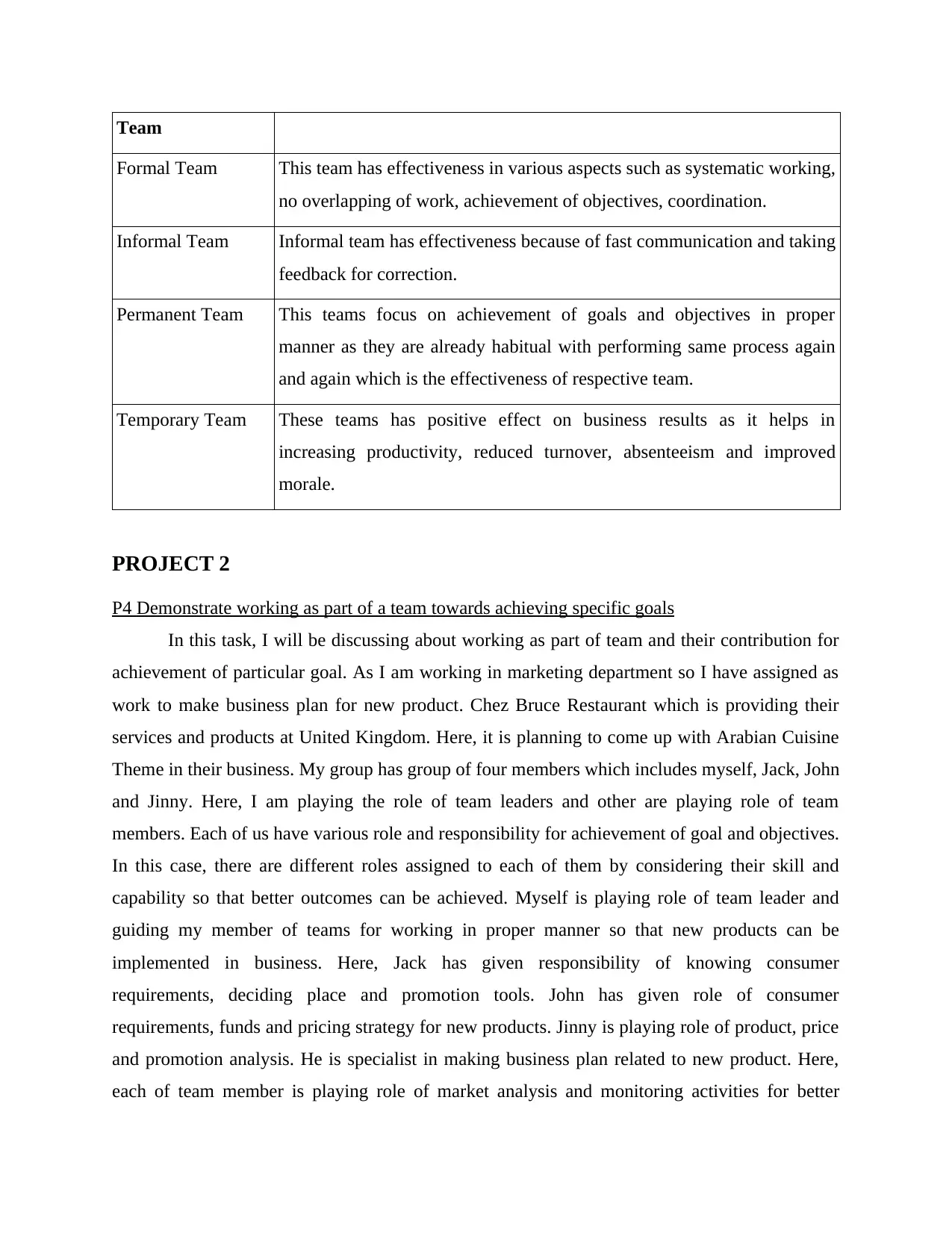
Team
Formal Team This team has effectiveness in various aspects such as systematic working,
no overlapping of work, achievement of objectives, coordination.
Informal Team Informal team has effectiveness because of fast communication and taking
feedback for correction.
Permanent Team This teams focus on achievement of goals and objectives in proper
manner as they are already habitual with performing same process again
and again which is the effectiveness of respective team.
Temporary Team These teams has positive effect on business results as it helps in
increasing productivity, reduced turnover, absenteeism and improved
morale.
PROJECT 2
P4 Demonstrate working as part of a team towards achieving specific goals
In this task, I will be discussing about working as part of team and their contribution for
achievement of particular goal. As I am working in marketing department so I have assigned as
work to make business plan for new product. Chez Bruce Restaurant which is providing their
services and products at United Kingdom. Here, it is planning to come up with Arabian Cuisine
Theme in their business. My group has group of four members which includes myself, Jack, John
and Jinny. Here, I am playing the role of team leaders and other are playing role of team
members. Each of us have various role and responsibility for achievement of goal and objectives.
In this case, there are different roles assigned to each of them by considering their skill and
capability so that better outcomes can be achieved. Myself is playing role of team leader and
guiding my member of teams for working in proper manner so that new products can be
implemented in business. Here, Jack has given responsibility of knowing consumer
requirements, deciding place and promotion tools. John has given role of consumer
requirements, funds and pricing strategy for new products. Jinny is playing role of product, price
and promotion analysis. He is specialist in making business plan related to new product. Here,
each of team member is playing role of market analysis and monitoring activities for better
Formal Team This team has effectiveness in various aspects such as systematic working,
no overlapping of work, achievement of objectives, coordination.
Informal Team Informal team has effectiveness because of fast communication and taking
feedback for correction.
Permanent Team This teams focus on achievement of goals and objectives in proper
manner as they are already habitual with performing same process again
and again which is the effectiveness of respective team.
Temporary Team These teams has positive effect on business results as it helps in
increasing productivity, reduced turnover, absenteeism and improved
morale.
PROJECT 2
P4 Demonstrate working as part of a team towards achieving specific goals
In this task, I will be discussing about working as part of team and their contribution for
achievement of particular goal. As I am working in marketing department so I have assigned as
work to make business plan for new product. Chez Bruce Restaurant which is providing their
services and products at United Kingdom. Here, it is planning to come up with Arabian Cuisine
Theme in their business. My group has group of four members which includes myself, Jack, John
and Jinny. Here, I am playing the role of team leaders and other are playing role of team
members. Each of us have various role and responsibility for achievement of goal and objectives.
In this case, there are different roles assigned to each of them by considering their skill and
capability so that better outcomes can be achieved. Myself is playing role of team leader and
guiding my member of teams for working in proper manner so that new products can be
implemented in business. Here, Jack has given responsibility of knowing consumer
requirements, deciding place and promotion tools. John has given role of consumer
requirements, funds and pricing strategy for new products. Jinny is playing role of product, price
and promotion analysis. He is specialist in making business plan related to new product. Here,
each of team member is playing role of market analysis and monitoring activities for better
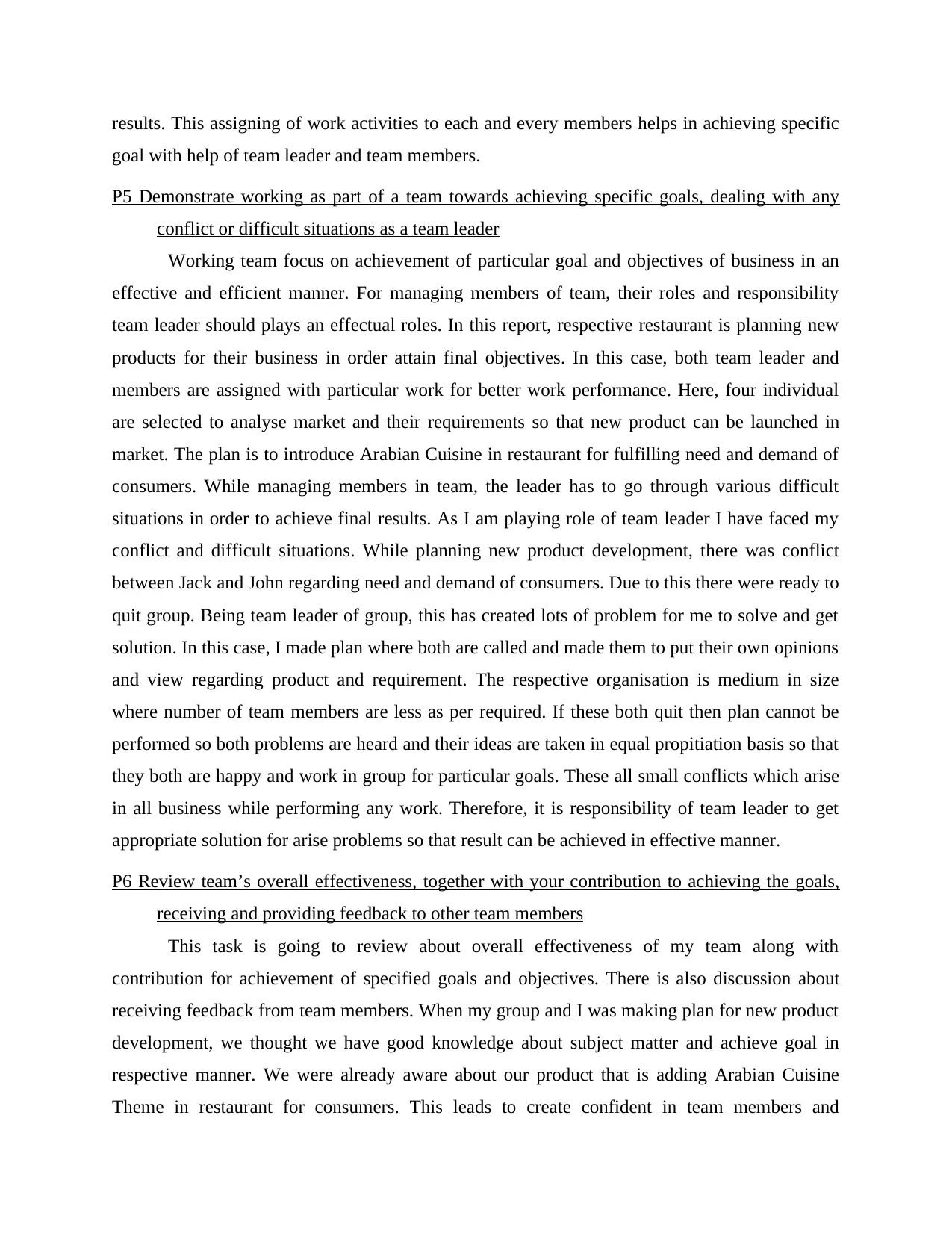
results. This assigning of work activities to each and every members helps in achieving specific
goal with help of team leader and team members.
P5 Demonstrate working as part of a team towards achieving specific goals, dealing with any
conflict or difficult situations as a team leader
Working team focus on achievement of particular goal and objectives of business in an
effective and efficient manner. For managing members of team, their roles and responsibility
team leader should plays an effectual roles. In this report, respective restaurant is planning new
products for their business in order attain final objectives. In this case, both team leader and
members are assigned with particular work for better work performance. Here, four individual
are selected to analyse market and their requirements so that new product can be launched in
market. The plan is to introduce Arabian Cuisine in restaurant for fulfilling need and demand of
consumers. While managing members in team, the leader has to go through various difficult
situations in order to achieve final results. As I am playing role of team leader I have faced my
conflict and difficult situations. While planning new product development, there was conflict
between Jack and John regarding need and demand of consumers. Due to this there were ready to
quit group. Being team leader of group, this has created lots of problem for me to solve and get
solution. In this case, I made plan where both are called and made them to put their own opinions
and view regarding product and requirement. The respective organisation is medium in size
where number of team members are less as per required. If these both quit then plan cannot be
performed so both problems are heard and their ideas are taken in equal propitiation basis so that
they both are happy and work in group for particular goals. These all small conflicts which arise
in all business while performing any work. Therefore, it is responsibility of team leader to get
appropriate solution for arise problems so that result can be achieved in effective manner.
P6 Review team’s overall effectiveness, together with your contribution to achieving the goals,
receiving and providing feedback to other team members
This task is going to review about overall effectiveness of my team along with
contribution for achievement of specified goals and objectives. There is also discussion about
receiving feedback from team members. When my group and I was making plan for new product
development, we thought we have good knowledge about subject matter and achieve goal in
respective manner. We were already aware about our product that is adding Arabian Cuisine
Theme in restaurant for consumers. This leads to create confident in team members and
goal with help of team leader and team members.
P5 Demonstrate working as part of a team towards achieving specific goals, dealing with any
conflict or difficult situations as a team leader
Working team focus on achievement of particular goal and objectives of business in an
effective and efficient manner. For managing members of team, their roles and responsibility
team leader should plays an effectual roles. In this report, respective restaurant is planning new
products for their business in order attain final objectives. In this case, both team leader and
members are assigned with particular work for better work performance. Here, four individual
are selected to analyse market and their requirements so that new product can be launched in
market. The plan is to introduce Arabian Cuisine in restaurant for fulfilling need and demand of
consumers. While managing members in team, the leader has to go through various difficult
situations in order to achieve final results. As I am playing role of team leader I have faced my
conflict and difficult situations. While planning new product development, there was conflict
between Jack and John regarding need and demand of consumers. Due to this there were ready to
quit group. Being team leader of group, this has created lots of problem for me to solve and get
solution. In this case, I made plan where both are called and made them to put their own opinions
and view regarding product and requirement. The respective organisation is medium in size
where number of team members are less as per required. If these both quit then plan cannot be
performed so both problems are heard and their ideas are taken in equal propitiation basis so that
they both are happy and work in group for particular goals. These all small conflicts which arise
in all business while performing any work. Therefore, it is responsibility of team leader to get
appropriate solution for arise problems so that result can be achieved in effective manner.
P6 Review team’s overall effectiveness, together with your contribution to achieving the goals,
receiving and providing feedback to other team members
This task is going to review about overall effectiveness of my team along with
contribution for achievement of specified goals and objectives. There is also discussion about
receiving feedback from team members. When my group and I was making plan for new product
development, we thought we have good knowledge about subject matter and achieve goal in
respective manner. We were already aware about our product that is adding Arabian Cuisine
Theme in restaurant for consumers. This leads to create confident in team members and
⊘ This is a preview!⊘
Do you want full access?
Subscribe today to unlock all pages.

Trusted by 1+ million students worldwide
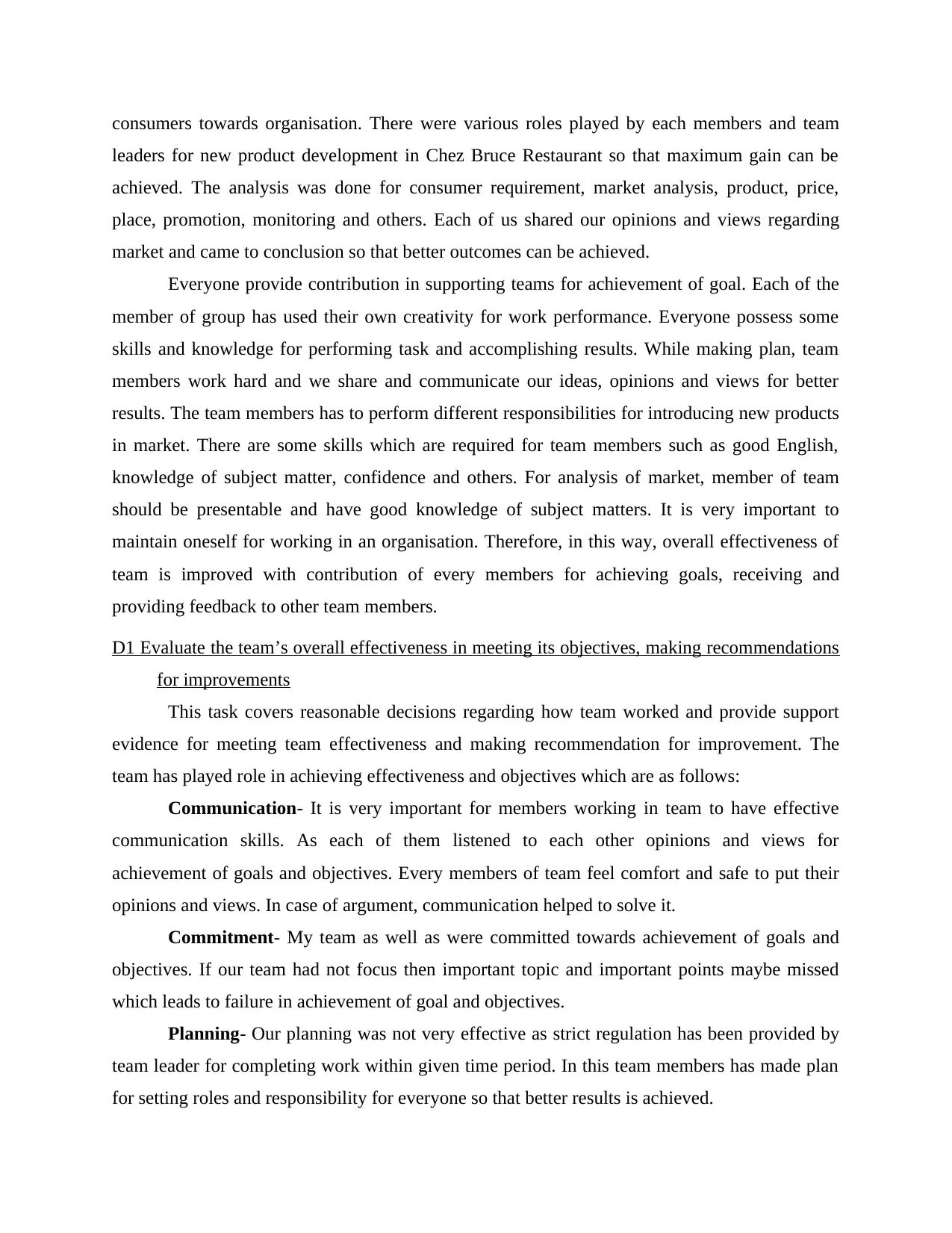
consumers towards organisation. There were various roles played by each members and team
leaders for new product development in Chez Bruce Restaurant so that maximum gain can be
achieved. The analysis was done for consumer requirement, market analysis, product, price,
place, promotion, monitoring and others. Each of us shared our opinions and views regarding
market and came to conclusion so that better outcomes can be achieved.
Everyone provide contribution in supporting teams for achievement of goal. Each of the
member of group has used their own creativity for work performance. Everyone possess some
skills and knowledge for performing task and accomplishing results. While making plan, team
members work hard and we share and communicate our ideas, opinions and views for better
results. The team members has to perform different responsibilities for introducing new products
in market. There are some skills which are required for team members such as good English,
knowledge of subject matter, confidence and others. For analysis of market, member of team
should be presentable and have good knowledge of subject matters. It is very important to
maintain oneself for working in an organisation. Therefore, in this way, overall effectiveness of
team is improved with contribution of every members for achieving goals, receiving and
providing feedback to other team members.
D1 Evaluate the team’s overall effectiveness in meeting its objectives, making recommendations
for improvements
This task covers reasonable decisions regarding how team worked and provide support
evidence for meeting team effectiveness and making recommendation for improvement. The
team has played role in achieving effectiveness and objectives which are as follows:
Communication- It is very important for members working in team to have effective
communication skills. As each of them listened to each other opinions and views for
achievement of goals and objectives. Every members of team feel comfort and safe to put their
opinions and views. In case of argument, communication helped to solve it.
Commitment- My team as well as were committed towards achievement of goals and
objectives. If our team had not focus then important topic and important points maybe missed
which leads to failure in achievement of goal and objectives.
Planning- Our planning was not very effective as strict regulation has been provided by
team leader for completing work within given time period. In this team members has made plan
for setting roles and responsibility for everyone so that better results is achieved.
leaders for new product development in Chez Bruce Restaurant so that maximum gain can be
achieved. The analysis was done for consumer requirement, market analysis, product, price,
place, promotion, monitoring and others. Each of us shared our opinions and views regarding
market and came to conclusion so that better outcomes can be achieved.
Everyone provide contribution in supporting teams for achievement of goal. Each of the
member of group has used their own creativity for work performance. Everyone possess some
skills and knowledge for performing task and accomplishing results. While making plan, team
members work hard and we share and communicate our ideas, opinions and views for better
results. The team members has to perform different responsibilities for introducing new products
in market. There are some skills which are required for team members such as good English,
knowledge of subject matter, confidence and others. For analysis of market, member of team
should be presentable and have good knowledge of subject matters. It is very important to
maintain oneself for working in an organisation. Therefore, in this way, overall effectiveness of
team is improved with contribution of every members for achieving goals, receiving and
providing feedback to other team members.
D1 Evaluate the team’s overall effectiveness in meeting its objectives, making recommendations
for improvements
This task covers reasonable decisions regarding how team worked and provide support
evidence for meeting team effectiveness and making recommendation for improvement. The
team has played role in achieving effectiveness and objectives which are as follows:
Communication- It is very important for members working in team to have effective
communication skills. As each of them listened to each other opinions and views for
achievement of goals and objectives. Every members of team feel comfort and safe to put their
opinions and views. In case of argument, communication helped to solve it.
Commitment- My team as well as were committed towards achievement of goals and
objectives. If our team had not focus then important topic and important points maybe missed
which leads to failure in achievement of goal and objectives.
Planning- Our planning was not very effective as strict regulation has been provided by
team leader for completing work within given time period. In this team members has made plan
for setting roles and responsibility for everyone so that better results is achieved.
Paraphrase This Document
Need a fresh take? Get an instant paraphrase of this document with our AI Paraphraser
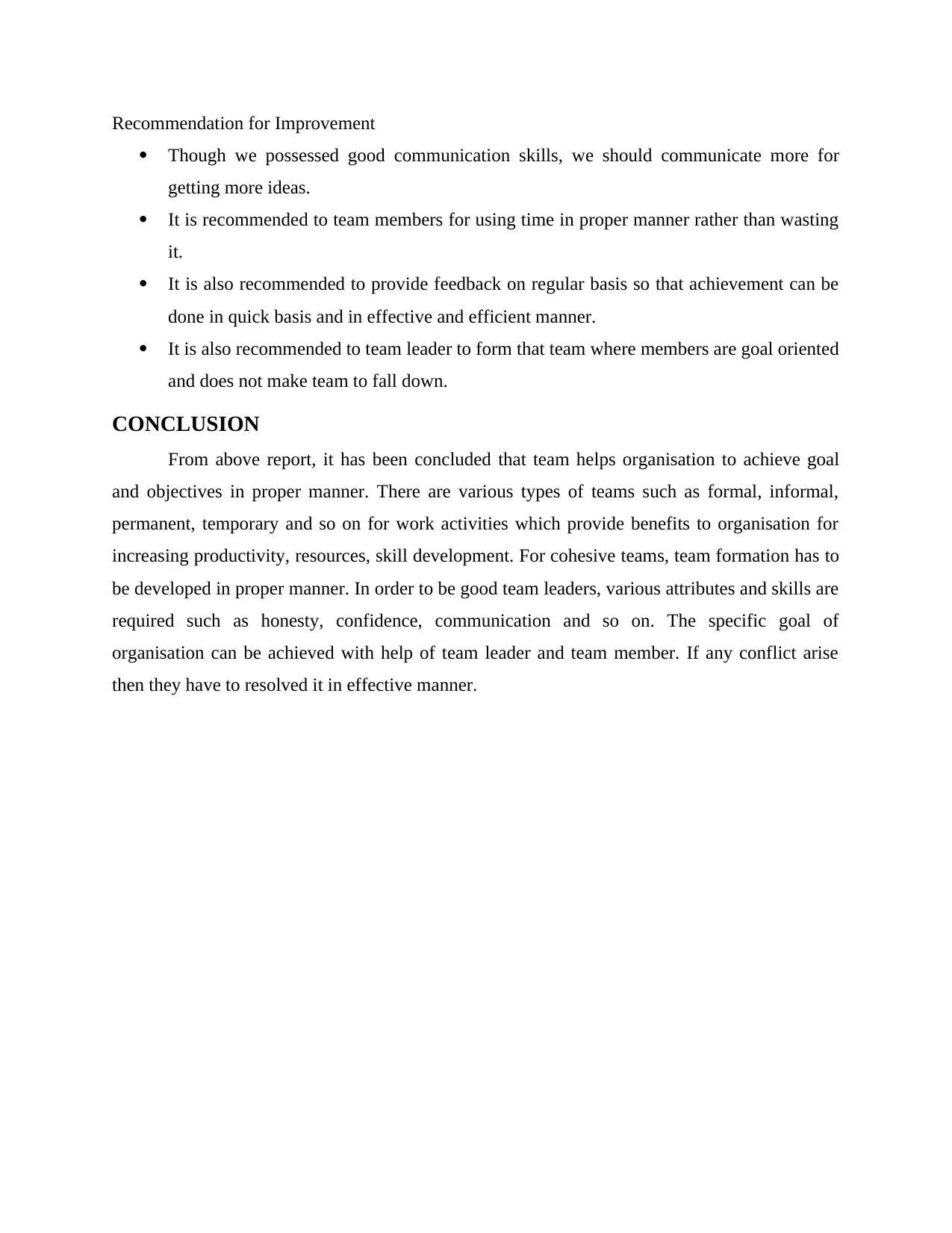
Recommendation for Improvement
Though we possessed good communication skills, we should communicate more for
getting more ideas.
It is recommended to team members for using time in proper manner rather than wasting
it.
It is also recommended to provide feedback on regular basis so that achievement can be
done in quick basis and in effective and efficient manner.
It is also recommended to team leader to form that team where members are goal oriented
and does not make team to fall down.
CONCLUSION
From above report, it has been concluded that team helps organisation to achieve goal
and objectives in proper manner. There are various types of teams such as formal, informal,
permanent, temporary and so on for work activities which provide benefits to organisation for
increasing productivity, resources, skill development. For cohesive teams, team formation has to
be developed in proper manner. In order to be good team leaders, various attributes and skills are
required such as honesty, confidence, communication and so on. The specific goal of
organisation can be achieved with help of team leader and team member. If any conflict arise
then they have to resolved it in effective manner.
Though we possessed good communication skills, we should communicate more for
getting more ideas.
It is recommended to team members for using time in proper manner rather than wasting
it.
It is also recommended to provide feedback on regular basis so that achievement can be
done in quick basis and in effective and efficient manner.
It is also recommended to team leader to form that team where members are goal oriented
and does not make team to fall down.
CONCLUSION
From above report, it has been concluded that team helps organisation to achieve goal
and objectives in proper manner. There are various types of teams such as formal, informal,
permanent, temporary and so on for work activities which provide benefits to organisation for
increasing productivity, resources, skill development. For cohesive teams, team formation has to
be developed in proper manner. In order to be good team leaders, various attributes and skills are
required such as honesty, confidence, communication and so on. The specific goal of
organisation can be achieved with help of team leader and team member. If any conflict arise
then they have to resolved it in effective manner.
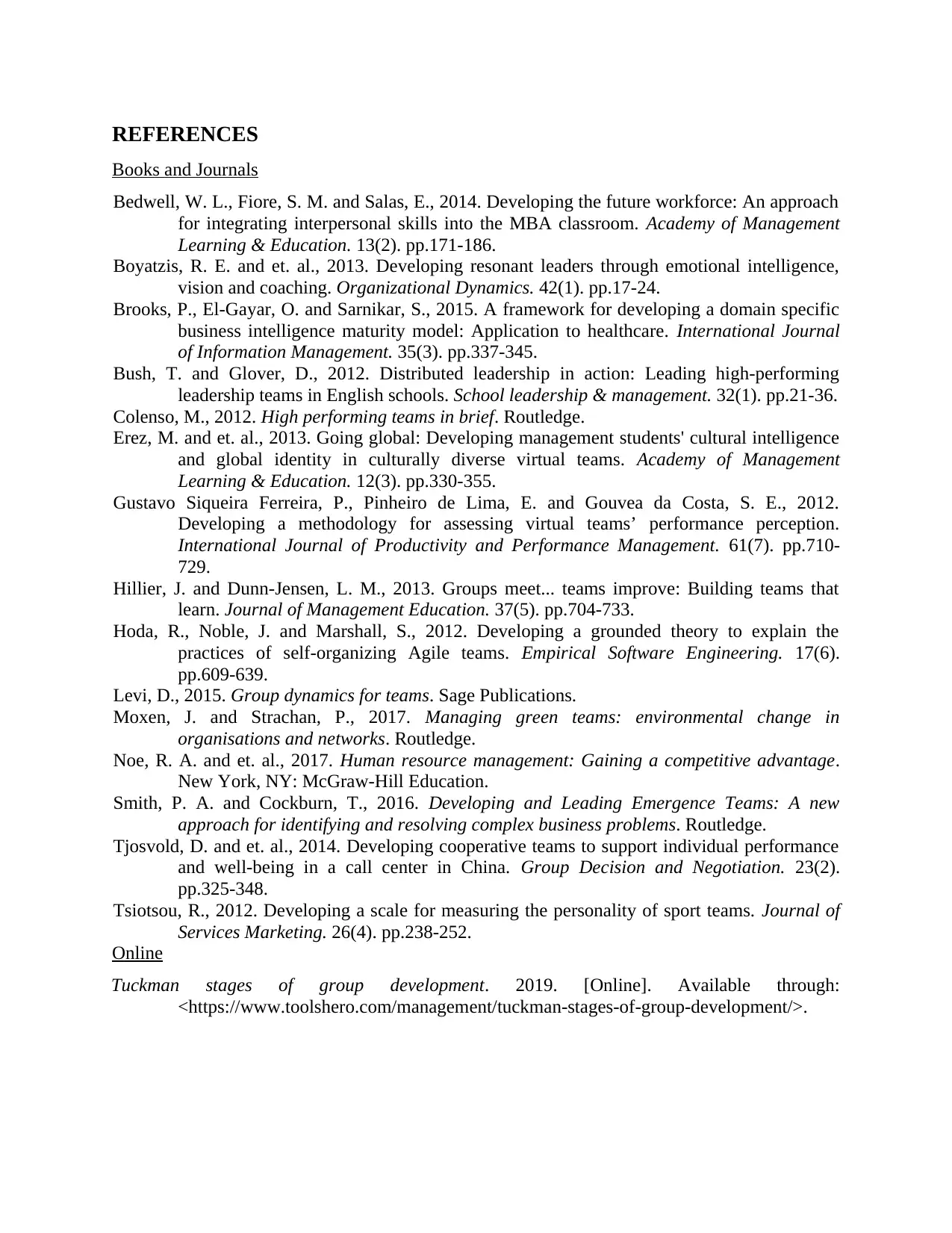
REFERENCES
Books and Journals
Bedwell, W. L., Fiore, S. M. and Salas, E., 2014. Developing the future workforce: An approach
for integrating interpersonal skills into the MBA classroom. Academy of Management
Learning & Education. 13(2). pp.171-186.
Boyatzis, R. E. and et. al., 2013. Developing resonant leaders through emotional intelligence,
vision and coaching. Organizational Dynamics. 42(1). pp.17-24.
Brooks, P., El-Gayar, O. and Sarnikar, S., 2015. A framework for developing a domain specific
business intelligence maturity model: Application to healthcare. International Journal
of Information Management. 35(3). pp.337-345.
Bush, T. and Glover, D., 2012. Distributed leadership in action: Leading high-performing
leadership teams in English schools. School leadership & management. 32(1). pp.21-36.
Colenso, M., 2012. High performing teams in brief. Routledge.
Erez, M. and et. al., 2013. Going global: Developing management students' cultural intelligence
and global identity in culturally diverse virtual teams. Academy of Management
Learning & Education. 12(3). pp.330-355.
Gustavo Siqueira Ferreira, P., Pinheiro de Lima, E. and Gouvea da Costa, S. E., 2012.
Developing a methodology for assessing virtual teams’ performance perception.
International Journal of Productivity and Performance Management. 61(7). pp.710-
729.
Hillier, J. and Dunn-Jensen, L. M., 2013. Groups meet... teams improve: Building teams that
learn. Journal of Management Education. 37(5). pp.704-733.
Hoda, R., Noble, J. and Marshall, S., 2012. Developing a grounded theory to explain the
practices of self-organizing Agile teams. Empirical Software Engineering. 17(6).
pp.609-639.
Levi, D., 2015. Group dynamics for teams. Sage Publications.
Moxen, J. and Strachan, P., 2017. Managing green teams: environmental change in
organisations and networks. Routledge.
Noe, R. A. and et. al., 2017. Human resource management: Gaining a competitive advantage.
New York, NY: McGraw-Hill Education.
Smith, P. A. and Cockburn, T., 2016. Developing and Leading Emergence Teams: A new
approach for identifying and resolving complex business problems. Routledge.
Tjosvold, D. and et. al., 2014. Developing cooperative teams to support individual performance
and well-being in a call center in China. Group Decision and Negotiation. 23(2).
pp.325-348.
Tsiotsou, R., 2012. Developing a scale for measuring the personality of sport teams. Journal of
Services Marketing. 26(4). pp.238-252.
Online
Tuckman stages of group development. 2019. [Online]. Available through:
<https://www.toolshero.com/management/tuckman-stages-of-group-development/>.
Books and Journals
Bedwell, W. L., Fiore, S. M. and Salas, E., 2014. Developing the future workforce: An approach
for integrating interpersonal skills into the MBA classroom. Academy of Management
Learning & Education. 13(2). pp.171-186.
Boyatzis, R. E. and et. al., 2013. Developing resonant leaders through emotional intelligence,
vision and coaching. Organizational Dynamics. 42(1). pp.17-24.
Brooks, P., El-Gayar, O. and Sarnikar, S., 2015. A framework for developing a domain specific
business intelligence maturity model: Application to healthcare. International Journal
of Information Management. 35(3). pp.337-345.
Bush, T. and Glover, D., 2012. Distributed leadership in action: Leading high-performing
leadership teams in English schools. School leadership & management. 32(1). pp.21-36.
Colenso, M., 2012. High performing teams in brief. Routledge.
Erez, M. and et. al., 2013. Going global: Developing management students' cultural intelligence
and global identity in culturally diverse virtual teams. Academy of Management
Learning & Education. 12(3). pp.330-355.
Gustavo Siqueira Ferreira, P., Pinheiro de Lima, E. and Gouvea da Costa, S. E., 2012.
Developing a methodology for assessing virtual teams’ performance perception.
International Journal of Productivity and Performance Management. 61(7). pp.710-
729.
Hillier, J. and Dunn-Jensen, L. M., 2013. Groups meet... teams improve: Building teams that
learn. Journal of Management Education. 37(5). pp.704-733.
Hoda, R., Noble, J. and Marshall, S., 2012. Developing a grounded theory to explain the
practices of self-organizing Agile teams. Empirical Software Engineering. 17(6).
pp.609-639.
Levi, D., 2015. Group dynamics for teams. Sage Publications.
Moxen, J. and Strachan, P., 2017. Managing green teams: environmental change in
organisations and networks. Routledge.
Noe, R. A. and et. al., 2017. Human resource management: Gaining a competitive advantage.
New York, NY: McGraw-Hill Education.
Smith, P. A. and Cockburn, T., 2016. Developing and Leading Emergence Teams: A new
approach for identifying and resolving complex business problems. Routledge.
Tjosvold, D. and et. al., 2014. Developing cooperative teams to support individual performance
and well-being in a call center in China. Group Decision and Negotiation. 23(2).
pp.325-348.
Tsiotsou, R., 2012. Developing a scale for measuring the personality of sport teams. Journal of
Services Marketing. 26(4). pp.238-252.
Online
Tuckman stages of group development. 2019. [Online]. Available through:
<https://www.toolshero.com/management/tuckman-stages-of-group-development/>.
⊘ This is a preview!⊘
Do you want full access?
Subscribe today to unlock all pages.

Trusted by 1+ million students worldwide
1 out of 12
Related Documents
Your All-in-One AI-Powered Toolkit for Academic Success.
+13062052269
info@desklib.com
Available 24*7 on WhatsApp / Email
![[object Object]](/_next/static/media/star-bottom.7253800d.svg)
Unlock your academic potential
Copyright © 2020–2025 A2Z Services. All Rights Reserved. Developed and managed by ZUCOL.


